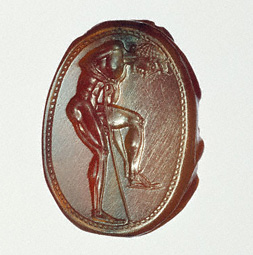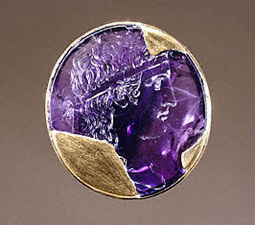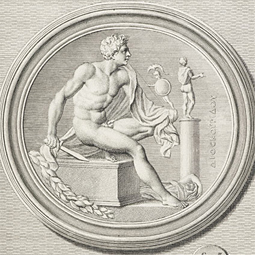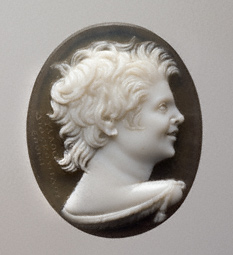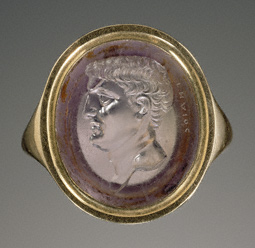Γλυπτογραφία . Η τεχνή της Γλυπτικής και της Χάραξης των πολύτιμων υλικών
Ειναι γεγονός οτι πολλές φορές οι μόνες μαρτυρίες που φθανουν στα χέρια μας
από αρχαίους, χαμένους στα βάθη του χρόνου, πολιτισμούς εiναι χαραγμένοι κρύσταλλοι που λόγω της σκληρότητάς τους άντεξαν την φθορά του χρόνου και με τις παραστάσεις που φέρουν επάνω τους δίνουν πολύτιμες πληροφορίες στους μελετητές τους για το επίπεδο πολιτισμού, τις συνήθειες και τις αξίες των ανθρώπων που έζησαν οταν τα έργα αυτά δημιουργήθηκαν. Αυτο συμβαίνει λόγω της σκληρότητας των ορυκτών κρυστάλλων που αποτελούν τον κύριο καμβά για τα έργα της Γλυπτογραφίας (σκληρότητα από 6,5 εως 10 στην κλίμακα του Moh οταν το ατσάλι εχει σκληρότητα 6 και το διαμάντι 10). Μέσα απο μια ποιητική ματια, προσδίδεται στα Γλυπτογραφικά έργα η ιδιότητα της Αφθαρσίας και της Αιωνιότητας.
Η τέχνη της Γλυπτογραφίας άνθισε από τον 6
ο αιώνα π.Χ. ως και τους ελληνιστικούς χρόνους και έφθασε στο απογειο της ακμής της κατα την περίοδο αυτή στον ελλαδικό χώρο απο οπου και έχουν διασωθεί οι πιό περίτεχνες γλυπτογραφίες.
Ονομαστοί γλυπτογράφοι ,όπως ο Μνήσαρχος απο την Σάμο (πατέρας του Πυθαγόρα) και ο Δεξαμενός απο την Χίο, δημιουργούσαν μεταξύ άλλων και σφραγιδόλιθους που οι έλληνες της εποχής έφεραν πάντα μαζί τους και τους χρησιμοποιούσαν για να αφήνουν το αποτύπωμα τους σε προσωπικά τους είδη οπως επίσης και στις πάσης φύσεως συναλλαγές τους. Στην αρχή φορούσαν τους χαραγμένους κρυστάλλους περασμενους σε σχοινάκια η δερματάκια στους καρπούς τους και αργότερα τους έδεναν με πολυτιμα μέταλλα και τους φόραγαν σε δακτυλίδια Χαρακτηριστικό της ευρείας χρήσης τους ήταν ο νόμος του Σόλωνος που απαγόρευε στους γλυπτογράφους να κρατουν αντίγραφο από τους σφραγιδόλιθους που δημιουργούσαν για τους πελάτες τους
Αγαπημενοι κρύσταλλοι των αρχαίων ελλήνων ήταν η Ορεία Κρύσταλλος (μία ποικιλία Χαλαζία που σαν κύριο χαρακτηριστικό της έχει την απόλυτη διαφάνεια), ο Χαλκηδόνιος (κρυπτοκρυσταλλικός Χαλαζίας που αφθονούσε στην περιοχή της αρχαίας Χαλκηδόνας),ο Καρνεόλης , ο Ιασπις κ.α.
Στους Αλεξανδρινούς οπως και μετέπειτα στους Ρωμαικούς χρόνους η ακαταμάχητη έλξη που ένιωθαν οι άνθρωποι για τα έργα της Γλυπτογραφίας συνεχίστηκε.
Στον Μεσαίωνα ομως η κατοχή των χαραγμένων κρυστάλλων μετατράπηκε σε προνόμιο των λίγων και αυτό είχε σαν αποτέλεσμα να μειωθεί ο αριθμός των εργαστηρίων και η τέχνη να παρακμάζει.
Αργότερα στην περίοδο της Αναγέννησης, η Γλυπτογραφία βρήκε πάλι την παλιά της αίγλη, για ένα μικρό χρονικό διάστημα. Η τέχνη αυτή αγαπήθηκε ιδιαίτερα απο τον Λεονάρντο Ντα Βίντσι και τον Μιχαήλ Αγγελο .Η οριστική παρακμή της ηλθε όμως με την επινόηση των γραμματοσήμων, οπότε έπαψε οριστικά η χρήση των σφραγιδόλιθων στην σφράγιση των επιστολών.

Ο φημισμένος Ρώσσος κοσμηματοποιός Peter Karl
Faberge (1846-1929) αγάπησε ιδιαίτερα την τέχνη αυτή και την αναβίωσε δημιουργώντας σειρές ολόκληρες έργων γλυπτογραφίας, όπως το ΖΟΟ , για τις τσαρικές και άλλες Ευρωπαικές βασιλικές αυλές.
 |
| Cecil Thomas(1889-1975) |
Κύριος συνεργάτης τού Faberge ήταν
ο Αlfred Lyndhurst Pocock (1881-1962) Αγγλος γλύπτης ,γλυπτογράφος ,γεωλόγος και ακουαρελίστας ,
o οποίος στις αρχές της δεύτερης δεκαετίας του εικοστού αιώνα σύστησε στον
Faberge τον
Cecil Tomas (1889-1975) Βρεταννό γλύπτη και γλυπτογράφο ο οποίος φιλοτεχνούσε συγχρόνως μεγάλων διαστάσεων γλυπτά που κοσμούν σήμερα πολλούς δημόσιους χώρους.
Ο Cecil Thomas σύνδεσε το όνομα του με τον οίκο Faberge και την ιστορική πλέον γλυπτογραφική δραστηριότητά του ενώ τού παραδόθηκε η σκυτάλη της γλυπτογραφίας από τους προκατόχους της Faberge και Pocock .
Μαθητής και συνεχιστής του Cecil Thomas υπήρξε ο Ελληνας απο την πλευρά της μητέρας του και Ιρλανδός απο την πλευρά του πατέρα του Nick Kielty- Lambrinides (1920-2004)γλυπτογράφος ,γεμμολόγος
Ο κατα γενική ομολογία τελευταίος Ευρωπαίος Master Γλυπτογράφος Νιck Kielty-Lambrinides έργα του οποίου βρίσκονται μεταξύ άλλων στο Victoria & Albert Museum του Λονδίνου, Μουσείο Γουλανδρή οπως και σε πολυάριθμες ιδιωτικές συλλογές ,αφού μαθήτευσε δίπλα στον Cecil Thomas ενστερνίστηκε πλήρως το Οραμα του δασκάλου του για την Αναβίωση της Γλυπτογραφίας.
Αμέσως μετα τον θάνατο του Cecil Thomas το 1975, ο Nick Kielty-Lambrinides εγκαταστάθηκε στην Ελλάδα και ίδρυσε στην Αθήνα την School of Glyptic Arts, πιστεύοντας οτι η Ελλάδα ήταν ο καταλληλότερος τόπος για να αναγεννηθεί η ξεχασμένη τέχνη της Γλυπτογραφίας.
Δύο λόγοι τον οδήγησαν σε αυτή την ισχυρή πεποίθηση.
Ο ένας ήταν το ότι η Γλυπτογραφία σαν τέχνη έφτασε στα απώτατα ύψη της στη Ελλάδα κατα την κλασσική αρχαιότητα , οπως μπορεί εύκολα κάποιος να διαπιστώσει απο την αξεπέραστη αισθητική και τεχνική τελειότητα αρχαίων εργων Γλυπτογραφίας που σώζονται σε μουσεία ανά τον κόσμο.
Ο αλλος λόγος ήταν η πίστη που είχε ο μεγάλος δάσκαλος καλλιτέχνης ,οτι στην Ελλάδα υπάρχει ένα πολύ πλούσιο σε πάσης φύσεως ταλέντα και δυνατότητες ανθρώπινο δυναμικο που συντηρεί μια παράδοση 6000 ετών στην Κοσμηματοποιία και το οποίο εάν επιμορφωθεί και εκπαιδευτεί σωστά μπορεί να μεγαλουργήσει και να προκαλέσει μια Αναγέννηση της Τέχνης της Γλυπτογραφίας.
Σαν τόπο εγκατάστασης της σχολής του διάλεξε το Μεταξουργείο ,γιατι εκεί ζούσαν και δημιουργούσαν οι Αθηναίοι Γλυπτογράφοι κατα την αρχαιότητα.
Eκεί αρχισε να διδάσκει την Τέχνη γλυπτογραφίας αλλά και την επιστήμη της Γεμμολογίας (Gemmology) = η επιστήμη της αναγώρισης και εκτίμησης των πολυτίμων λίθων και υλικών – λέξη προερχόμενη απο την ελληνική λέξη Γαία- Γέμμα-Γή - καθώς αυτή η γνώση είναι απαραίτητη για τον Γλυπτογράφο δεδομένου οτι οι κρυσταλλικοί λίθοι αποτελούν τα υλικά του, τον καμβά του. Η σχολή του
Δίπλα του μαθήτευσε η Μαρία Αποστολοπούλου , ιδρυτικό μέλος και βασική σχεδιάστρια της ομάδας Cosmochaos , η οποία αφού διδάχθηκε τα μυστικά της τέχνης της γλυπτογραφίας από το μεγάλο δάσκαλο Nick Kielty-Lambrinides, γλυπτογραφεί ακολουθώντας τους δικούς της δρόμους. Μέσα από την πολυετή προσωπική της πορεία έχει καταφέρει να θέσει τις βάσεις για τη σύγχρονη μορφή της Γλυπτογραφίας . Εντάσσοντας τους σκαλισμένους λίθους της σε κοσμήματα δικού της σχεδιασμού φέρνει την αρχαία αυτή τέχνη στο προσκήνιο και σε επαφή με το πλατύ κοινό . Η Μαρία Αποστολοπούλου οραματιζόμενη την εξέλιξη αυτής της τέχνης δημιούργησε τον μοναδικό στην Ευρώπη πυρήνα Ελλήνων Γλυπτογράφων , μαθητών ,συνεχιστών της σχολής Faberge-Cecil Thomas - Nick kielty -Lambrinides. Ο πυρήνας αυτός λειτουργεί στην Αθήνα υπό τη σκέπη του COSMOCHAOS απο το 1994 εως και σήμερα.
























